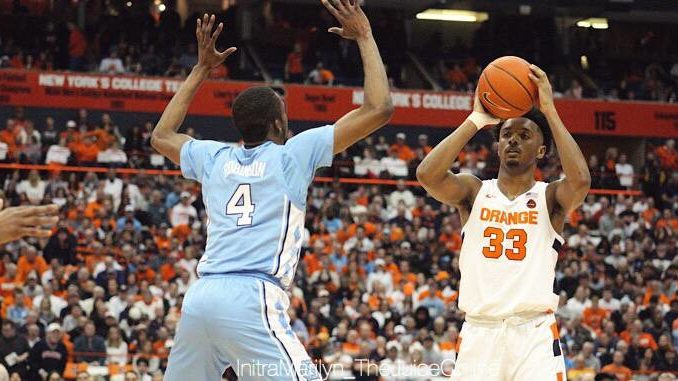
In recent seasons, the game of basketball has shifted more toward a reliance on three-point shooting. The movement started in the NBA as the three-point shot from the corner of the court became valued in a proposition of “shortest distance from the basket, but worth the most points”. The strategic trend has continued, now including a willingness of players to shoot from increasingly longer distances, led by Stephen Curry and Damian Lillard.
In the college ranks, Syracuse is one of the teams most affected by the three-point shot. Their 2-3 zone looks to force three-point attempts from their opponents, particularly contested shots and shots farther back than just behind the arc with a lower likelihood of finding the bottom of the net.
Orange opponents are generally happy to comply with this, taking an extremely high percentage of field goals from three-point range, as evidenced by the rate of total field goal attempts that are three-pointers and their rank in Division One in each of the last eight seasons:
- 2013-2014: .405, 11th
- 2014-2015: .374, 79th
- 2015-2016: .397, 43rd
- 2016-2017: .428, 24th
- 2017-2018: .445, 15th
- 2018-2019: .481, 5th
- 2019-2020: .479, 3rd
- 2020-2021: .442, 17th
Those last four seasons of evidence underscore the general trend in basketball toward the three-point shot.
While the 2-3 zone has traditionally forced long balls, the Orange are getting into bombing away on offense at nearly a similar rate, pending their personnel from season to season. Here is where SU stands in rate of total field goal attempts that are three-pointers and their rank in Division One in each of the last eight seasons:
- 2013-2014: .270, 313th
- 2014-2015: .290, 292nd
- 2015-2016: .421, 42nd
- 2016-2017: .406, 73rd
- 2017-2018: .328, 294th
- 2018-2019: .432, 72nd
- 2019-2020: .421, 69th
- 2020-2021: .403, 95th
Getting back to the Orange zone defense, it really is more effective when it forces opponents to rely on long-range shooting. When at least half of an opponent’s field goal attempts come from beyond the arc, the Orange are 49-17 (.742). When less than one-third of an opponent’s shots come from outside the arc, SU is a lot less successful at 22-24 (.478).
In the last eight seasons, Syracuse has allowed opponents to make 32.5 percent of their three-point tries. When the 2-3 holds their opponents under that mark, the Orange are 101-37 (.732) compared to 65-64 (.504) when they permit over 32.5 percent proficiency from long range.
Unsurprisingly, that win-loss mark gets better the more opponents miss. SU is 87-23 (.791) when they allow 30 percent or lower three-point shooting.
» Related: Syracuse basketball players whose jerseys should be retired
Syracuse’s success is mirrored in the number of three-pointers they allow:
- SU opponent makes 0-4 threes – 27-10 (.730)
- SU opponent makes 5-8 threes – 78-45 (.634)
- SU opponent makes 9 or more threes – 61-46 (.570)
- SU opponent makes 12 or more threes – 12-14 (.462)
In those 37 games where an opponent maxed out at four threes made, SU gave up permitted the opposition to make over 30 percent of their three-point shots three times. The Orange lost each game, allowing four triples in each.
On offense, the Orange have shot 33.8 percent from three-point range in the last eight seasons. When SU has been less proficient than that average, they are 69-76 (.476).
But, when the Orange exceed 33.8 percent shooting from long range, they sport a 97-25 (.795) mark. And when they make at least 36.7 percent of their attempts from distance, the Orange are 85-16 (.842).
Unlike on the defensive end, there is no direct line of success based on the total number of triples Syracuse makes.
- SU makes 0-4 threes – 38-17 (.691)
- SU makes 5-8 threes – 67-70 (.489)
- SU makes 9 or more threes – 61-14 (.813)
- SU makes 12 or more threes – 24-7 (.774)
Most of those games where the Orange connected on four threes or fewer feel like distant memories, as only nine of them have come in the last three seasons as the team’s offense has tilted toward the arc. In other words, they used to make somewhere between zero and four threes in a game nine times a season, but have now done it nine times in the last three seasons combined.
When you cross the offensive and defensive results at their greater success rates that are still fairly close to their long-term averages (33.8 percent or better on offensive threes, 30 percent or better on threes allowed), Syracuse is just about unstoppable, standing 48-4 (.923).
(Three of those four losses had the same root cause – major rebounding problems. Two defeats were at the hands and long arms of North Carolina in games four years apart where they were outrebounded by a margin of at least 17 and another was a game when SU finished -15 on the glass against Virginia Tech.)
The 32.5 percent of their three-pointers the Orange have permitted foes to make over the last eight seasons is not far from that 30 percent ideal. That small statistical difference is almost always less than one three falling or not. Getting the team’s three-point defense just a little bit tougher would go a long way to helping SU win more.
In all this looking at eight years of the long ball, there was one odd stat I would be remiss in not sharing:
- In 166 Syracuse wins, the Orange have shot 36.7 percent from three and their opponents 29.9 percent.
- In 101 Syracuse losses, their opponents have shot 36.7 percent from three and the Orange 29.6 percent.
For more Syracuse coverage, Like our Facebook page, follow us @TheJuiceOnline and listen to our podcast.

